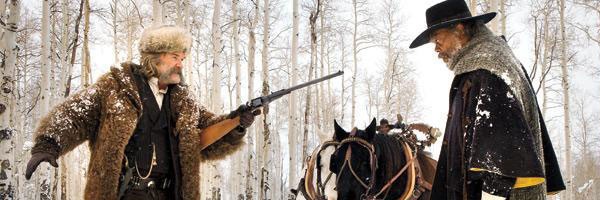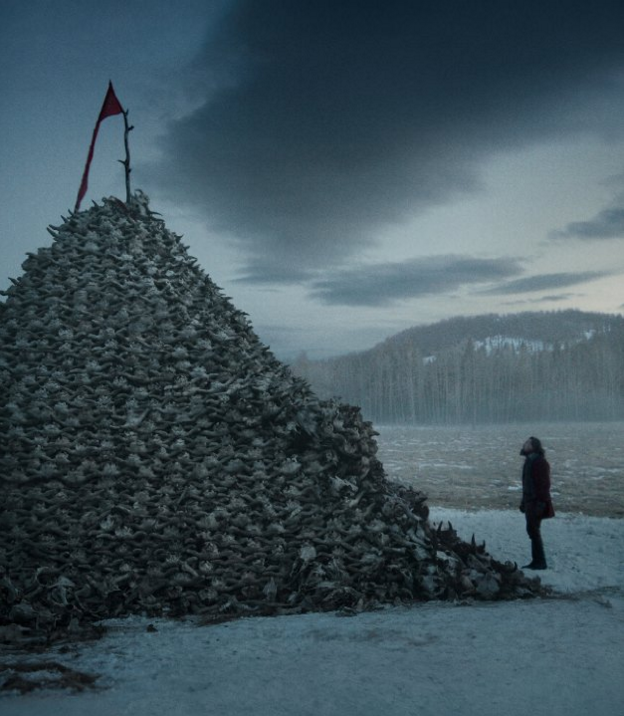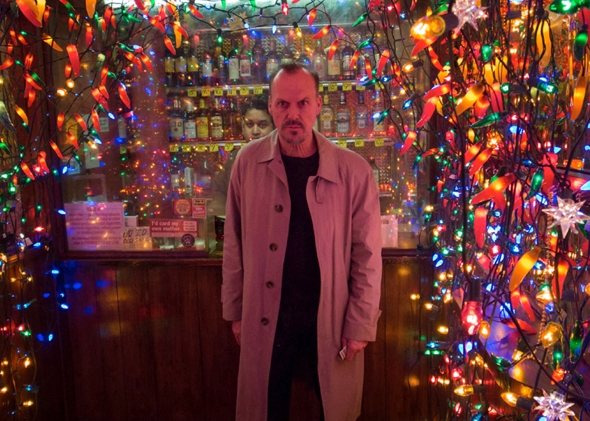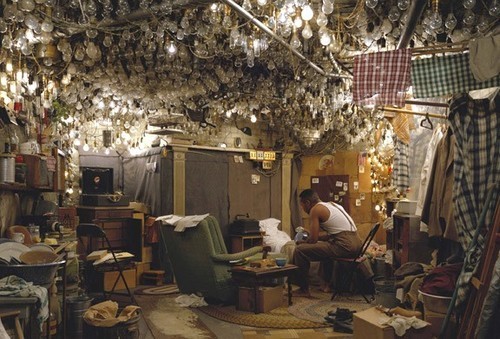A RETURN TO FORM WITH A REVIEW ON THE HATEFUL EIGHT

It’s a new year and we, meaning the royal we, shall begin with a renewed fury. In 2015 I took time away from this blog to focus on other projects, but now it is time to renew my commitment to this site and the writing. I hope I can continue to provide a unique perspective on American culture, focused on the intersection of our ever diminishing society and the art that it produces.
[Spoiler Alert]
Last Monday (12/28) I went to see the latest film by the supercilious director Quentin Tarantino, The Hateful Eight. My expectations were high having thoroughly enjoyed Django Unchained (2012), Tarantino’s revisionist commentary on slavery in the American south. Although far from a masterpiece (a term that is all too often thrown about along with genius, these days) I felt Django balanced well between pulp operatics, witty repartee, and cartoon violence that has become the signature of Tarantino’s work. When a Tarantino script works, it gives rise to banal conversations that act as trojan horses toward greater tension and hints at the history of film. The violence becomes a counterpoint to the everyday, suggesting rightfully that underneath American life flows a red tinted river of brutality. What made Django Unchained function at a high level, was the clever interplay of elements that Tarantino has refined over the course of seven films.
[youtube https://www.youtube.com/watch?v=6_UI1GzaWv0&w=560&h=315]
The Hateful Eight breaks the Tarantino arc, destroying all subtlety with rapid, rapacious indignation. Where Kill Bill, Django Unchained, Jackie Brown, and of course Pulp Fiction succeed, The Hateful Eight fails with near spectacular free fall. Most, if not all of the familiar Tarantino dialogue is rendered as louche, simplistic phrases where the characters speak to apparently hear their own voices more than provide artistic expression. Staged character devises used so effectively in the past; the dignified but vengeful black man, the surprisingly resilient and lion-hearted woman, the mysterious foreigner, all become redundant, overused tropes in this film. The characters aside from a few brief exceptions, are cutouts in a store window display, their intent to conjure a memory of character’s past, archetypes of the Tarantino oeuvré, but lacking any real substance. This is so true that it borders on racist stereotypes throughout the film. Tim Roth’s Oswaldo Mobray is the stereotypical effete Londoner with a disdain for all things American. Michael Madsen’s John Gage follows suit as the loner 'cowboy' from the American west, hinting at, but falling far short of his predecessors Clint Eastwood, Yul Brynner, Charles Bronson, or even Henry Fonda in My Name is Nobody. It goes on, Walton Goggins, the racist southern rebel; Kurt Russell, the principled bounty hunter; Demián Bichir Nájera, the snarky Mexican; and lest we forget Tarantino’s favorite black actor, Samuel L. Jackson appearing here as Major Marquis Warren, a cartoonish foil for racial indignity surviving slavery and the Civil War to seek fortune as a bounty hunter in the West. There are tidbits that come entirely from the deftness of the mostly gifted cast, that hold back complete catastrophe, most notably Jennifer Jason-Leigh and the legendary Bruce Dern. What makes The Hateful Eight so painful to watch is the lack of substantive dialogue provided to such an outstanding group of actors, leaving perhaps Madsen, Tatum, and Goggins aside. If you’ve had the good fortune to watch Soderbergh’s Che, than you saw a great performance by Demián Bichir as Fidel Castro. In The Hateful Eight, Tarantino gives him nothing but mumbling insouciance.
Where the character archetypes of Tarantino’s past breakdown, so too does the the soundtrack and cinematography. Tarantino’s deep knowledge of the history of cinema, makes the choice of Ennio Morricone the composer for The Good, The Bad, and The Ugly and Once Upon a Time in the West an obvious choice. Although on several levels I would say the score for The Hateful Eight is far from Morricone’s best, it is more noticeable in how it is applied in a rip shod way. Bursts of music push through at times in the movie as though they’re ensuring audience alertness more than cinematic verity. The opening Overture in the tradition of movie Roadshows, acted more as a placeholder than a tension builder. It felt repetitive rather than a crescendo, which mirrors the general tone of the film. The uneven use of music throughout the film matched the unusual choice of the resurrected Ultra Panavision 70mm film format. The widest aspect ratio film ever created (2.76:1) Ultra Panavision 70 was only seen a smattering of times between 1957 and 1966. The aspect ratio projected on a huge curved screen begs for sweeping, majestic cinematography that loves sweeping vistas, and awe inspiring landscapes. The last film to be shown in Ultra Panavision 70, Khartoum leverages it beautifully as an introduction to the ancient, exotic aesthetics of Egypt and Sudan. Although The Hateful Eight was shot in the backcountry of Telluride, Colorado little of it is capitalized on during the movie. Early scenes of birds taking flight, panoramic mountain landscapes and the distant shots of a six-horse stage coach pushing through deep snow are the only real glimpses you get of Ultra Panavision 70’s unique quality. Much of the balance of the film is shot indoors (in one room) in a barn, or in white-out conditions. Hardly a qualifier for the majesty of a long lost camera technique. It all inevitably feels like so much hubris instead of art. Tarantino can’t even help himself by providing two segments of awful expository voice over that adds nothing to the film other than enriching his own ego.
Then there is the violence. Layer upon layer of mind-numbing graphic violence. Throughout much of the film I felt witness to the gladiatorial spectacle of a Roman coliseum where human sadism was laid bare for public entertainment. Early on the film disposes with any gentleness when Kurt Russell delivers a crushing elbow to the face of Jennifer Jason-Leigh, and that is just the tip of the iceberg. The violence continues to surge forth in wave upon wave of ever greater graphic display—heads blown to jelly, expurgations of sprayed blood, and continuous beatings of the only female character (the others are ghosts brought back in flashback who suffer no better a fate). This theatrical barbarous blood bath leaves you with only two choices; revulsion or mindless celebration. Unfortunately I heard too much celebration in the theater during the showing which begs a deeper commentary on American sadism. At one point there is so much bodily fluid and brain matter scattered about Eli Roth would blush. All of this blood, gore, and guts only serves as a fantastical mask that obscures the fact that this is a terribly written film. My sense is that the snowy setting was only employed to embellish the contrast of blood red against stark white, a weak, didactic ploy at its best.
The Hateful Eight is Hollywood at its worst. It is a film that wallows in the current American desire for more violence built on a culture of fear. I’m sure some critics and academics will argue that The Hateful Eight is a cinematic exposition on our times. I am not one of those. The whiteness of the film’s blizzard is an apt metaphor for the blankness of content. The Hateful Eight comes across as cheap torture porn and lazy filmmaking where a director is out of ideas and only has his own canon to drawn down on again and again, ad infinitum.











 There is a surprising amount of water in Alejandro Iñárritu’s The Revenant. The film begins with water and ends with water. Water is the central metaphor for what it is to be human. Humanity and nature can be both fluid and an unstoppable force, soft and hard. The power of The Revenant lies not in its unrelenting fury, but in its subtle grasp of an uncaring universe.
There is a surprising amount of water in Alejandro Iñárritu’s The Revenant. The film begins with water and ends with water. Water is the central metaphor for what it is to be human. Humanity and nature can be both fluid and an unstoppable force, soft and hard. The power of The Revenant lies not in its unrelenting fury, but in its subtle grasp of an uncaring universe. 

